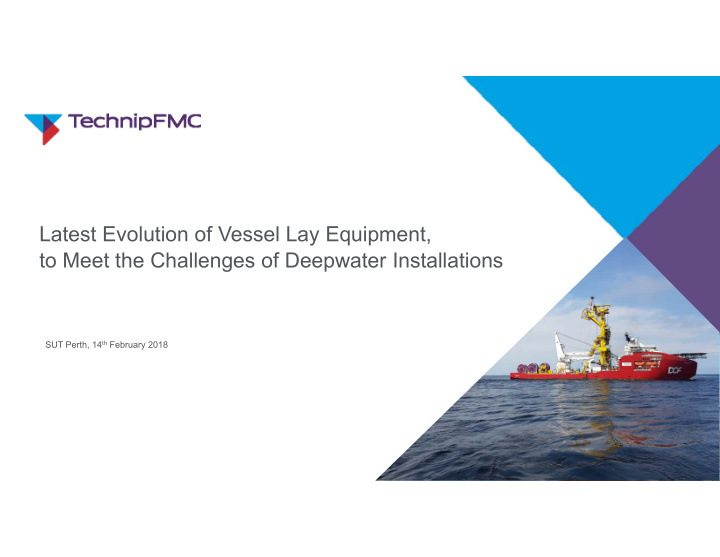



Latest Evolution of Vessel Lay Equipment, to Meet the Challenges of Deepwater Installations SUT Perth, 14 th February 2018
1. TechnipFMC Fleet 2. Skandi Africa: Crane Lay Spread Page footer text | 2
TechnipFMC Fleet S ‐ LAY VESSELS REEL ‐ LAY VESSELS Deep Energy Apache II Deep Blue G1201 G1200 LONG TERM CHARTERED VESSELS RLWI DIVE SUPPORT VESSELS Island Performer North Sea Giant North Sea Atlantic Deep Explorer Deep Arctic Plus 8 purpose built vessels for the Brazilian Market: CONSTRUCTION VESSELS Skandi Vitoria* Skandi Acu* Skandi Niteroi* Skandi Buzios* Coral Do Atlantico Skandi Olinda* Estrela Do Mar Skandi Recife* Skandi Africa Deep Orient *JV with DOF
Skandi Africa Overview
Skandi Africa A state ‐ of ‐ the ‐ art deepwater construction support vessel Length: 160.9 meters ► Speed: 12 ‐ 16 knots ► Accommodation: 140 people ► DP3 and ICE ‐ 1B class notation for harsh environments ► 900 Te AHC main crane, 150 Te AHC knuckle ‐ boom crane ► Large 2,700m2 main deck and 3,500Te under deck storage ► 2 TXLX ROV systems capable of operating to 4,000 m ► 650 Te Tiltable Lay System Tower (TLS) for flexible lay operations – product ► diameter from 50 to 630mm 50 ‐ 630 mm 650 Te 3500 Te Maximum product Tiltable Lay System Under Deck Carousel diameter range onboard vessel
Crane Developments
Crane Developments A fully programable system: At the push of a button Main Stages of a Subsea Lift improved: Vessel to Vessel Lift Mode Splash Zone Mode Subsea Land-out Mode Deep Water Lowering Mode Increased workability & reduce strain on system
Crane Developments 1) Vessel to Vessel Lift Mode Main considerations: Personnel Safety during rigging Structure Integrity during ops Structure control in-air Outcome: Account for vessel to vessel relative motions Remove ‘Snap-load’ risk DAF reduced / optimised lifting configurations Increased operability Increased safety
Crane Developments 2) Splash Zone Mode Main considerations: Maximise wave kinematics Risk of slack-lining Hull clashing Outcome: Reduced exposure to slack slings Increased vessel operability [Hs]
Crane Developments 3) Subsea Land-out Mode Main considerations: Structure designed for specific landing velocity [~0.5m/s] Suction loads risk / overloading, landing on soft seabed Structure position guidance Outcome: Seabed recontact risk mitigated Remove overload risk, crane attached to seabed Increased vessel operability [Hs] Page footer text | 10
Crane Developments 4) Deep Water Lowering Mode Main considerations: Crane slewed forward & inboard Resonance* Resonance Mitigation: Natural period of resonance shifted outside wave period range Traditional route: Pennants & PHC unit Block 31 – Resonance Issue Experienced *Resonance – Excitation of the lifted package caused by the natural frequency of the hoisting system being near the wave period – generally more of an issue in deeper waters
Crane Developments Crane Simulation Modelling [CSM] Crane manufacturer interface SKAF Orcaflex lifting scenario Main Crane Fed into complex model Resonance Mitigation Benefits PHC units removed Reducing risk of crane damage Reduced vessel time: ~ €1.0M saving on 1 st Project Significant operability increase - 1.0m Hs to 2.0m Hs CSM cost only €15k Page footer text | 12
Lay Spread Development *Special mention to Huisman for their input to these slides ‐ www.huismanequipment.com/en/ Page footer text | 13
Lay Spread Developments A Drive for Innovation Changing infrastructure, remote, deeper waters Upscaling and improved handling Deeper water & Larger equipment = Higher top tension Safety and structural integrity consideration: Longer, heavier & more end terminations Improved efficiency, repeatability, safety Efficient, safe installation = higher lay speed
Lay Spread Developments Page footer text | 15
Lay Spread Developments End Handling System [EHS] – 1 st & 2 nd End Improved efficiency, control & safety Chinese fingers, loose rigging & multiple winches removed Driven rigid arm, rotated around aligner wheel Hoisting pipe termination from deck - latching system 180° rotation into firing line Fully reversible for recovery Horizontal motions fixed
Lay Spread Developments Retractable Dual Tensioners: Retract out of firing line when not required Full ramp height available ‘XYZ’ Hoisting Beams: Conventional hoisting beams setup set at fixed pitch Movable beams increase versatility & reduce rigging time Beams skid transversely & independently Heavy loads transported from side of ramp to firing line
Lay Spread Developments
Successfully implemented on…… Total Moho Nord [Congo] - 1200mwd Large EPCI Over 21km of flexibles Associated Structures, Jumpers, etc Total Kaombo [Angola] – 1900mwd 400 day SKAF campaign 500+ Team in 17 TechnipFMC centres 50+ Rigid Spools & Jumpers 18 Dynamic & Static Umbilicals 14 structures [manifolds & piles]
Thank you
Recommend
More recommend